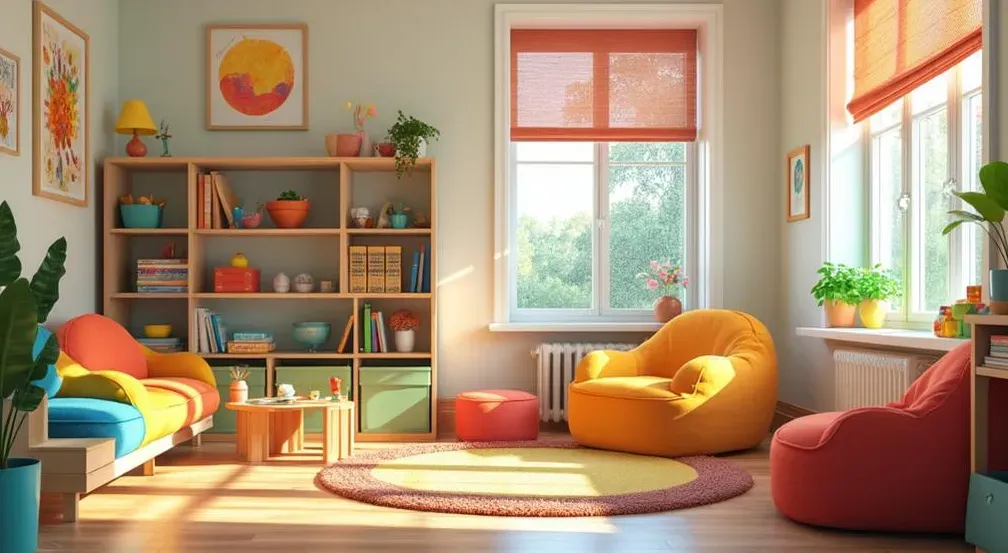Kid-Friendly Interiors That Aren’t an Eyesore

By
Shrusti Naik
Posted on June 3, 2025. 10 mins

Kid-Friendly Interiors That Aren’t an Eyesore

Designing a kid-friendly home that is both functional and stylish can seem like a daunting task. However, with the right approach, you can create a space that is both safe for your children and visually appealing. In this blog, we will explore practical tips and design ideas that can help you achieve a kid-friendly interior without compromising on style. From choosing the right materials to incorporating cultural elements, we'll cover everything you need to know to create a home that feels both welcoming and sophisticated.
Understanding Kid-Friendly Design Principles in India

Designing a kid-friendly home in India means embracing principles that cater to the cultural context of Indian families. Here are some key principles to keep in mind:
Safety First: In bustling Indian homes, ensuring children’s safety is crucial. Use non-toxic paints, rounded furniture edges, and secure fittings to prevent accidents. Childproof electrical outlets and anchor heavy furniture to avoid tipping. Besides, if you are looking at lighting your wall, you can visit our guide on wall light design.
Durability and Easy Maintenance: Indian homes are lively and active. Choose materials that withstand wear and tear. Opt for durable fabrics like microfiber or leather for upholstery, and robust flooring like laminate or tile that’s easy to clean.
Flexibility and Adaptability: Indian homes host frequent gatherings and varied activities. Spaces must be flexible. Modular furniture that reconfigures for different uses is perfect. Think sofas with hidden storage or tables that fold away.
Multifunctional Spaces: With space often at a premium, design multifunctional rooms. A child’s bedroom can include a study nook, play area, and ample storage. Foldable desks, bunk beds with storage, and wall-mounted shelves maximize space efficiency.
Stylish Furniture and Decor: Balancing Tradition and Modernity

Creating a home that’s both kid-friendly and stylish in India is like making a perfect masala dosa, crisp on the outside but soft and delightful on the inside. It’s all about blending traditional aesthetics with modern design to ensure your home is culturally rich and appealing for young families.
Blend of Tradition and Modernity: Think of a carved wooden bed frame with sleek, minimalist lines, it’s like wearing a kurta with jeans. Combining traditional Indian craftsmanship with modern design elements keeps your home both stylish and rooted in culture.
Durable Materials: Choose materials that can withstand the wear and tear of an active household. Teak and Sheesham wood are like the Rajinikanth of furniture, strong and timeless. Upholstery should be easy to clean, such as leather or stain-resistant fabrics. We can also get inspired by the beautiful houses of the bollywood celebrities such as Tiger Shroff and Shilpa Shetty
Safety: Ensure furniture is kid-friendly with rounded edges and non-toxic finishes. After all, we don’t want little Aarav or Ananya bumping into sharp corners during a game of hide-and-seek.
Incorporating Chic Decor Elements

Vibrant Textiles: Use colorful, patterned textiles like cushions, rugs, and curtains to add a touch of traditional Indian vibrancy to modern spaces. Kantha quilts and block-printed fabrics can serve as beautiful decor elements, bringing a slice of tradition into contemporary settings.
Handcrafted Furniture: Invest in handcrafted pieces showcasing Indian artistry, like intricately carved wooden chests or hand-painted cabinets. These items add character and uniqueness to your home, much like a well-told Bollywood story.
Sustainable Materials: Opt for eco-friendly materials such as bamboo, jute, and recycled wood. These materials are not only durable but also support sustainable practices. It’s like adding a bit of green chutney to your decor, refreshing and responsible. If you are looking for colour combinations for other rooms in your house you can view our guide of top room combinations.
Significance of Local Crafts and Artisanal Pieces

Using locally crafted items supports local artisans and keeps traditional skills alive. Madhubani paintings, Rajasthani pottery, or handwoven baskets can serve as stunning decor pieces. These elements enhance your home’s aesthetic appeal and instill a sense of cultural pride and heritage.
Creating Functional and Inclusive Spaces for Kids

Personalizing Kids’ Rooms with Cultural Sensitivity
Personalizing kid-friendly rooms while maintaining a culturally sensitive and stylish look involves incorporating elements that reflect Indian traditions and values.
Using Colour, Themes, and Personalized Decor:
Cultural Colors and Patterns: Use colors and patterns that are significant in Indian culture. Saffron, emerald, and deep blues, along with paisley or floral patterns, can be used in bedding, curtains, and wall decor. It’s like dressing up the room in festive attire.
Themes: Choose themes that resonate with Indian culture and heritage, such as folklore, mythology, or nature. Murals or wall decals depicting stories from the Ramayana or Mahabharata can be both educational and decorative. Besides, if you are searching for designs to paint your wall, you can visit our guide on wall painting designs.
Involving Children in the Design Process:
Ownership and Pride: Allow children to participate in the design process by letting them choose colors, themes, and decor items. This involvement fosters a sense of ownership and pride in their space.
Personal Touches: Incorporate items that reflect their personalities and interests, such as custom name plaques, favorite toys, or hobby-related decor.
Integrating Elements that Celebrate Indian Festivals and Milestones:
Festive Decor: Use decorations that celebrate Indian festivals like Diwali, Holi, and Raksha Bandhan. A dedicated shelf for diyas and rangoli designs during Diwali or colorful powders and water guns for Holi makes the room feel special.
Cultural Artifacts: Display traditional artifacts like brass lamps, handcrafted dolls, or miniature models of historical monuments to educate children about their heritage.
Milestone Celebrations: Decorate the room with items that celebrate significant milestones such as birthdays, religious ceremonies, or academic achievements. Photo walls, certificates, and trophies can make a child feel proud of their accomplishments.
Practical Tips for a Kid-Friendly Home

Anti-Tip Furniture for a Rock-Solid Setup
Kids don’t see a bookshelf as just a storage unit they see it as a climbing wall. Large furniture pieces like bookshelves, cabinets, and dressers can be potential hazards if not secured. Anti-tip kits can be your best friend here. They ensure that large furniture stays firmly anchored to the wall, no matter how adventurous your little ones get. To elevate your bedroom and create a good impression among your loved ones, check out out blog on bedroom colour combinations.
Kid-Friendly, Washable Paint
Walls are every child’s first canvas. Instead of stopping their creativity, embrace it by using washable, kid-friendly paint. These paints are easy to clean, allowing you to wipe away crayon marks, pencil doodles, and sticky fingerprints with a single swipe.
Spill-Proof Rugs & Flooring
Juice spills, muddy shoes, and art projects gone rogue, kids put floors to the test every day. That’s why it’s smart to choose kid-friendly flooring options like vinyl, hardwood, or laminate. For an extra layer of protection (and style), use washable area rugs. They’re soft for playtime and can be easily thrown in the wash.
Clever Storage
Nothing makes a space feel more chaotic than toy clutter. But with smart storage options like bins, baskets, and built-in shelves, you can keep play areas tidy. Storage that’s within arm’s reach of your kids also encourages them to clean up after themselves.
Conclusion
Creating a kid-friendly home doesn’t mean sacrificing style. With smart storage, rounded furniture, clever safety tools, and easy-to-clean materials, you can create a space where your kids can play, learn, and grow safely. From splash-proof floors to security cameras that give you peace of mind, these small changes make a big impact. Your home will be a place where fun meets function and that’s a win for the whole family. For those in pursuit of their dream home, investment opportunities, or a sanctuary to call their own, Jugyah provides top housing solutions with its intelligent technology.
Frequently Asked Questions
Q1. How can I make my home kid-friendly without compromising on style?
- Focus on safety, durability, and flexibility. Use rounded furniture edges, non-toxic paints, and easy-to-clean materials. Incorporate stylish storage solutions and cultural elements to maintain a sophisticated look.
Q2. What are some practical tips for creating a kid-friendly bathroom?
- Install non-slip flooring, childproof locks on cabinets, and a safe, easy-to-reach faucet. Use washable, kid-friendly paint and consider adding a colorful, waterproof rug for added comfort.
Q3. How can I personalize my child’s room while maintaining a stylish aesthetic?
- Involve your child in the design process by letting them choose colors, themes, and decor items. Use cultural elements and artifacts to add a personal touch while keeping the overall design sophisticated.
Q4. What are some kid-friendly flooring options?
- Opt for durable and easy-to-clean flooring options like vinyl, hardwood, or laminate. Washable area rugs can provide additional comfort and protection.
Q5. How can I ensure my home is safe for my children?
- Use anti-tip kits to secure large furniture, install childproof locks on cabinets, and ensure electrical outlets are covered. Choose rounded furniture edges and non-toxic materials to prevent accidents.